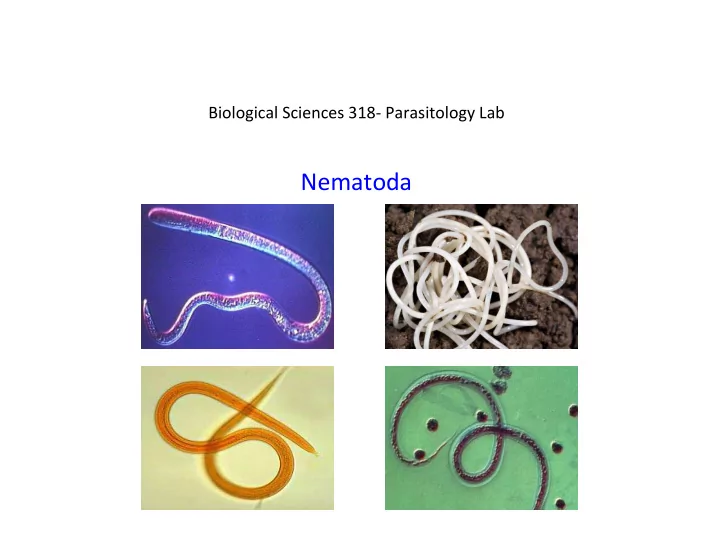

Biological ¡Sciences ¡318-‑ ¡Parasitology ¡Lab ¡ ¡ ¡ Nematoda ¡ ¡
Kingdom: ¡Animalia ¡ ¡ (unranked): ¡Protostomia ¡ ¡ (unranked): ¡Spiralia ¡ ¡ clade: ¡Nematoida ¡ ¡ ¡ Class Order Trichinella ¡ ¡ ¡ Trichuris ¡ ¡ ¡ ¡ Mermis ¡ ¡ Phylum: ¡ ¡ ¡ ¡ ¡ ¡ ¡ ¡ ¡ ¡ Strongyloides ¡ Rhabdina ¡ ¡ ¡ ¡ Hooksworms ¡ Trichostrongyles ¡ ¡ Ascaris ¡ Anisakis ¡ Enterobius ¡ ¡ Filarial ¡worms ¡ Dracunculus ¡
Nematodes Characteristics: Nematodes occupy almost every possible niche: As parasites they infect vertebrates, insects, and plants, as free-living organisms they are found in soil, fresh water and sea water. They are a highly successful group of organisms, second only to the insects. Despite their diversity of habitat, the nematodes have a remarkable consistency of shape. This consistency of form is brought about by the constraints of their morphology: 1) bilaterally symmetrical animals (non-segmented) 2) Body contains internal cavity (pseudocoelom) 3) Vermiform, long and slender with pointed ends 4) Complete Digestive System 5) Most are dioecious; (Female w. vulva, Males w. cloaca) 6) Develop by molting, shedding cuticle 7) Development: egg, egg fertilization, embryo in egg, larva, 4 molts, adult M1 M2 M3 M4 Egg J1 J2 J3 J4 Adult
Nematoda Morphology • tube within a tube • Body wall: thick cuticle, a hypodermis, layer of longitudinal muscle • Pseudocoel functions as hydrostatic skeleton- common in invertebrates • Digestive system is complete- mouth, gut, anus • Reproduction: ♀ tube subdivided into Ovary, oviduct, uterus, vulva (gential pore) ♂ chitinous spicule, vas deferens joins digestive tract to form cloaca
Nematoda ¡ Enoplea ¡ Rhabditea ¡ Order ¡ Order ¡ Order ¡ Order ¡ Order ¡ Spirurida ¡ Strongylida ¡ Oxyurida ¡ Trichurida ¡ Ascaradida ¡ (Filarial ¡worms) ¡ (Hookworms) ¡ (Pinworms) ¡ (Whipworms) ¡
Learning Objectives 1. Know general characteristics 11. Ancylostoma caninum - Know what is special about their cuticle + epidermis - Where? - Know development + morphology - Host, mouthparts – buccal capsule, caudal bursa (copulatory bursa) 2. Order Trichurida - Visual id in copula, male, female - Know general characteristics for id + anatomy 12. Necator americanus 3. Trichuris trichura - Where? - Human whipworm - Visual ID male, female, eggs - Epidemiology, anatomy - Mouthparts – caudal bursa - Purpose of thick and thin end 13. Order Spirurida - Visual id males, females, eggs - General characteristics - Embryonation, infectivity 14. Superfamily Filarioidae 4. Trichinella spiralis - Filarial worm - (adult slide not good) - General characteristics - Largest intracellular parasite 15. Onchocerca volvulus - Life cycle, tissue + transmission - Life cycle, pathology - Females are viviparous - Vector - What is special about larvae? - Visual id nodule cross-section containing adults containing microfilariae - Why are they hard to eradicate? lots of reservoir hosts 16 . Wuchereria bancrofti - Visual id male , female, larvae encysted, muscle infected / larvae section - Life cycle, pathology, disease, transmission Vocabulary 5. Order Ascarida - Visual id mircofilariae Cuticle - General characteristics Epidermis 6. Ascaris lumbricoides Dioecious - Epidemiology, pathology Cloaca - Size Vulva - Life cycle, transmission, bronchial escalator Filiform - Eggs, embryonated or unembryonated, number of eggs (thick outer shell, persistence) Stichosome - Cross section: id parts+ sex Stichocytes 7. Order Oxyurida Viviparous - Know general charactersitics Nurse cell 8. Enterobius vermicularis Bronchial escalator - Pinworm Spicule - Most common nematode parasite of human Oviparous - Life cycle, transmission Caudal bursa - Itchy bum Buccal capsule - Visual id female, male Microfilaria 9. Order Strongylida Nocturnal periodicity 10. Superfamily Ancylostomatoidae Filarial worms - Hookworms Pinworms - General characteristics Hookworms - Life cycle Whipworms
Recommend
More recommend